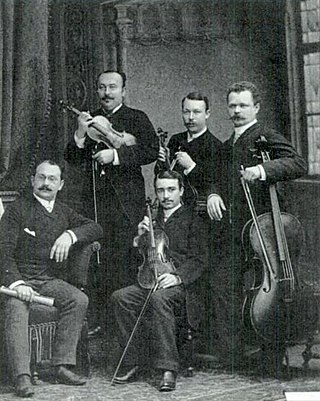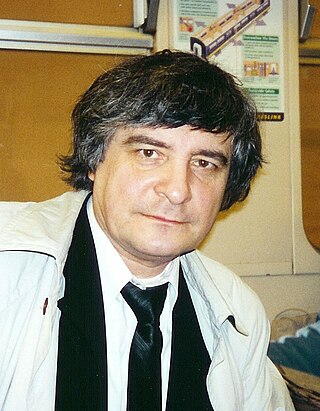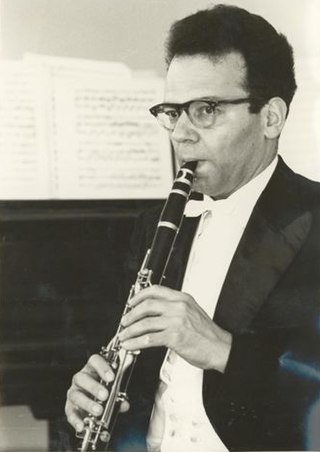Related Research Articles

The term string quartet can refer to either a type of musical composition or a group of four people who play them. Many composers from the mid-18th century onwards wrote string quartets. The associated musical ensemble consists of two violinists, a violist, and a cellist.

In classical music, a piano quintet is a work of chamber music written for piano and four other instruments, most commonly a string quartet. The term also refers to the group of musicians that plays a piano quintet. The genre particularly flourished during the nineteenth century.
Dmitri Shostakovich's String Quartet No. 8 in C minor, Op. 110, was written in three days.
D major is a major scale based on D, consisting of the pitches D, E, F♯, G, A, B, and C♯. Its key signature has two sharps. Its relative minor is B minor and its parallel minor is D minor.
A major is a major scale based on A, with the pitches A, B, C♯, D, E, F♯, and G♯. Its key signature has three sharps. Its relative minor is F-sharp minor and its parallel minor is A minor. The key of A major is the only key where the Neapolitan sixth chord on (i.e. the flattened supertonic) requires both a flat and a natural accidental.
F major is a major scale based on F, with the pitches F, G, A, B♭, C, D, and E. Its key signature has one flat. Its relative minor is D minor and its parallel minor is F minor.

B-flat major is a major scale based on B♭, with pitches B♭, C, D, E♭, F, G, and A. Its key signature has two flats. Its relative minor is G minor and its parallel minor is B-flat minor.
E-flat major is a major scale based on E♭, consisting of the pitches E♭, F, G, A♭, B♭, C, and D. Its key signature has three flats. Its relative minor is C minor, and its parallel minor is E♭ minor,.
D minor is a minor scale based on D, consisting of the pitches D, E, F, G, A, B♭, and C. Its key signature has one flat. Its relative major is F major and its parallel major is D major.
F-sharp minor is a minor scale based on F♯, consisting of the pitches F♯, G♯, A, B, C♯, D, and E. Its key signature has three sharps. Its relative major is A major and its parallel major is F-sharp major.

The Piano Trio No. 2 in E minor, Op. 67, is a piece for violin, cello and piano by the Russian composer Dmitri Shostakovich, started in late 1943 and completed in August the following year. It was premiered on 14 November 1944. The piece was dedicated to his close friend Ivan Sollertinsky, whose death in February 1944 affected Shostakovich profoundly.

Dmitri Nikolaevich Smirnov was a Russian-British composer and academic teacher, who also published as Dmitri N. Smirnov and D. Smirnov-Sadovsky. He wrote operas, symphonies, string quartets and other chamber music, and vocal music from song to oratorio. Many of his works were inspired by the art of William Blake.
Dmitri Shostakovich's String Quartet No. 14 in F-sharp major, Op. 142, was composed in 1972–73. It is dedicated to Sergei Shirinsky, the cellist of the Beethoven Quartet, the ensemble that premiered most of Shostakovich's quartets. The first performance was held in Leningrad on November 12, 1973.
Dmitri Shostakovich's String Quartet No. 6 in G major, Op. 101, was composed in 1956. It was premiered by the Beethoven Quartet but carries no dedication. The Beethoven Quartet recorded this work on the Mezhdunarodnaya Kniga label.

Dmitri Shostakovich's String Quartet No. 10 in A-flat major, Op. 118, was composed from 9 to 20 July 1964. It was premiered by the Beethoven Quartet in Moscow and is dedicated to composer Mieczysław (Moisei) Weinberg, a close friend of Shostakovich. It has been described as cultivating the uncertain mood of his earlier Stalin-era quartets, as well as foreshadowing the austerity and emotional distance of his later works. The quartet typified the preference for chamber music over large scale works, such as symphonies, that characterised his late period. According to musicologist Richard Taruskin, this made him the first Russian composer to devote so much time to the string quartet medium.
Dmitri Shostakovich's String Quartet No. 12 in D-flat major, Op. 133, was composed in 1968. It is dedicated to Dmitri Tsyganov, the first violinist of the Beethoven Quartet, which premiered the work in Moscow on June 14.
DSCH is a musical motif used by the composer Dmitri Shostakovich to represent himself. It is a musical cryptogram in the manner of the BACH motif, consisting of the notes D, E-flat, C, B natural, or in German musical notation D, Es, C, H, thus standing for the composer's initials in German transliteration: D. Sch..
The Concerto in C minor for Piano, Trumpet, and String Orchestra, Op. 35, was completed by Dmitri Shostakovich in 1933.

Yona Ettlinger was a clarinetist who played and taught in Israel, France and England. Ettlinger is considered a prominent classical clarinetist of his generation, and one of Israel's notable instrumentalists. His musicianship and unique sound influenced the art of clarinet playing in Israel and Europe in the second half of the 20th century. Many clarinet soloists and orchestra players of different countries were among his students.
References
- ↑ McBurney, Gerard. "Dmitri Shostakovich - Piano Quintet in G Minor". Boosey and Hawkes. Retrieved 14 March 2020.